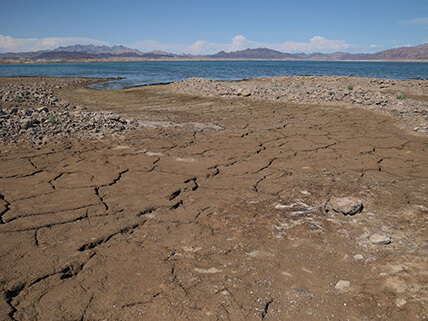
The water level in Lake Mead has dropped more than 1,000 feet.
A drought is a long period without rain. When a drought lasts longer than two decades it is classified as a megadrought. Large parts of the western United States are currently suffering through a megadrought, possibly the worst one in over a thousand years. Texas, Arizona, New Mexico, Utah, Nevada, California, and Wyoming are just some of the states that have been affected.
Several of the states impacted by the megadrought rely on the Colorado River. The river provides water for drinking and irrigation, and also generates electricity by feeding into hydroelectric power stations. Dams along the river form the two largest reservoirs in the United States—Lake Mead and Lake Powell. Both reservoirs reached record low water levels this year. In fact, the last time Lake Mead was at full level was in 1983. If Lake Mead’s water level drops much more it could reach “dead pool” status. This means the water level is too low to reach hydroelectric power stations at Hoover Dam—making a bad situation even worse.
Droughts in 2022 have brought with them significant hardships around the world. But, they’ve also contributed to some amazing discoveries. As water levels in Texas’s Paluxy River dropped they uncovered a rare find—dinosaur footprints. Receding waters in Lake Mead have uncovered a crashed WWII airplane, prehistoric arrowheads, and several shipwrecks. Parts of Europe and Asia have also seen ancient artifacts uncovered. In Spain, a prehistoric stone circle, similar to Stonehenge, has emerged from the depths of the Valdecanas reservoir. In China, three statues of Buddha carved more than 600 years ago have resurfaced.
There’s no way of predicting when the current megadrought will end. Scientist have only identified a handful of megadroughts in the history of Earth. They do this by analyzing the rings in cut, cross-sections of trees. Each ring represents a year of growth. From tree rings, scientist can determine when floods, droughts, and other climate events have occurred in the past.
The longest known megadrought lasted about 30 years. The current megadrought is entering its twenty-third year. In the short term, people in the western United States will need to conserve water. In fact, the United States government and Mexico have reached an agreement to cut water usage from the Colorado River. Some western states will need to make cuts of up to 25 percent.
Scientists estimate that it will take several years of above-average rainfall to end the megadrought. The U.S. government and others around the world are also working to address the larger issue of climate change. The hope is that by tackling climate change, we can lessen the effects of, or even avoid, natural disasters like the megadrought.
A majority of scientists believe that the burning of fossil fuels, such as coal and gas, for energy contributes to global warming and climate change. This year, President Biden signed a new climate law that provides money for alternative energy sources, such as wind and solar power. The hope is that by 2030 cleaner energy sources will reduce greenhouse gas emissions by as much as 50 percent. Greenhouse gas emission are one of the main drivers of global warming.
Image credit: ©Ronda Churchill/ZUMA Press/NewsCom
Sources
- Scorching, global drought has uncovered lost artifacts around the world
(Source: ABC News; accessed September 1, 2022) - Deadline looms for western states to cut Colorado River use
(Source: AP News; accessed September 1, 2022) - Hot nights: US in July sets new record for overnight warmth
(Source: AP News; accessed September 1, 2022) - Northeastern farmers face new challenges with severe drought
(Source: AP News; accessed September 1, 2022) - Western states hit with more cuts to Colorado River water
(Source: AP News; accessed September 1, 2022) - The latest on the Colorado River and Lake Mead report
(Source: CNN; accessed September 1, 2022) - US issues western water cuts as drought leaves Colorado River near ‘tipping point’
(Source: The Guardian; accessed September 1, 2022) - US west ‘megadrought’ is worst in at least 1,200 years, new study says
(Source: The Guardian; accessed September 1, 2022) - Total Wildland Fires and Acres (1983-2021)
(Source: National Interagency Fire Center; accessed September 1, 2022) - U.S. Megadrought Is Worst for Over 1,000 Years: How Long Could It Last?
(Source: Newsweek; accessed September 1, 2022) - What Scientists Say about the Historic Climate Bill
(Source: Scientific American; accessed September 1, 2022) - Tree Rings and Climate
(Source: University Corporation for Academic Research; accessed September 1, 2022) - Lost villages, ancient ruins, WWII ships uncovered as extreme heat lowers water levels
(Source: USA Today; accessed September 1, 2022)



